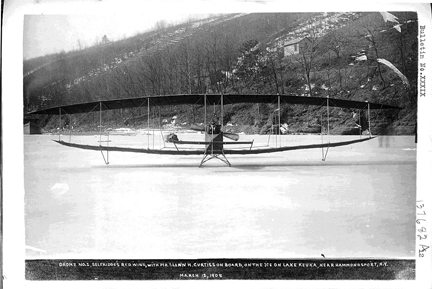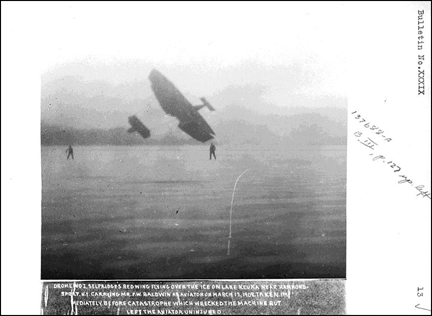The Red Wing - Aerodrome 1
After experimenting with Alexander Graham Bell's large tetrahedral kite, the Cygnet, in Baddeck, Nova Scotia in December of 1907, the Aerial Experiment Association moved to Hammondsport, New York to continue their work.
In Hammondsport, they had access to the factory of the Curtiss Motorcycle Company, owned by Glenn H. Curtiss. Space, machinery and some staff were put at the disposal of the AEA so that they could carry out the work of designing and building airplanes, or as Dr. Bell called them, aerodromes.
A glider was first designed using some the of the principles of gliders built by Chicago aviation pioneer Octave Chanute. It was constructed with the involvement of all the members. The glider was tested off the hills in Hammondsport and each member of the AEA took turns at riding it off the snow-covered slopes. The glider provided some practical basis for the decisions on wing structure and fuselage for the first aerodrome.
Lt. Thomas E. Selfridge was then designated by the members of the AEA to build the initial aerodrome. He based his plans on the best information available to the Association.

Front view of the Red Wing, on the frozen surface of Lake Keuka in Hammondsport, NY.
The Red Wing was a single seat, biplane powered by a Curtiss 40 hp V-8 engine. The propeller and engine were placed behind the pilot's seat, a single board with a back, and was designed to push the aircraft forward.
The wingspan measured 13.21 metres (43ft, 4 in). The fuselage was 4 metres (26 ft) long. It was constructed of sturdy bamboo and handcrafted pieces of spruce and ash. Wire cross structure was added to the frame and between the biplane wings to provide structural strength while keeping the weight down. A moveable rudder at the rear of the aircraft was designed to move the device from left to right as necessary. Lateral control was to be provided, as it had been on the AEA's glider, by having the pilot shift his weight to the right and left and hopefully keep the wings parallel for flight.
The aerodrome had no wheels but was placed on skids attached to the fuselage to provide a surface that would allow it to slide forward over the frozen surface of Lake Keuka when it was under power.
The craft was named the Red Wing after the silk cloth covering used on the wings. The material was the same as that used to cover the tetrahedral cells in Bell's large kites and had been shipped to the Curtiss plant from the Kite House on the Bell estate in Baddeck. The color red had been chosen by Bell since it provided good contrast against the sky and helped to provide good photographic documentation of all his aerial experiments.

Side view of the Red Wing showing the slender fuselage, the rudder at the rear and the position of the motor behind the pilot's position. Note also the runners as undercarriage for the aerodrome.
Selfridge was called away to Army duties at Fort Myer, Virginia just as the craft was completed, so he did not fly the aerodrome. Casey Baldwin and Glenn Curtiss took the aircraft on a few taxi runs to get a feel for the controls. Curtiss was especially interested in ensuring that the engine and propeller were operating properly prior to attempting a flight.
Baldwin was selected as the pilot on March 12th, essentially because he was the only one on the ice with the aerodrome that did not have skates on. The propeller was spun, the engine started and the Red Wing, with Baldwin and the others standing beside it, began to skid across the ice. The skaters, including Curtiss and McCurdy, managed to hold it in place while Baldwin climbed aboard.1
After taxiing for 91 metres (150 ft), Baldwin managed to fly the Red Wing successfully for twenty seconds covering a distance of 97 metres (319 ft) at an elevation of about 3 to 6 metres (10 to 20 ft). There was no wind to create stability problems and the craft flew until the engine quit. Baldwin managed to glide it down to the surface of the ice.
Although the Wright Brothers had achieved the first controlled powered flight in 1903 in North Carolina, the flight of the Red Wing is often credited with being the first publicly witnessed flight in the United States.
The Red Wing's engine was removed and freed up prior to a second flight test on March 17, 1908. The associates waited for a period of calm winds on that day and then fired up the engine for another flight. Shortly after becoming airborne, the Red Wing experienced turbulence. A gust of wind tipped up one wing sending the craft in an unstable fall toward the ice. The rudder and one wing were smashed. The craft sustained so much damage that it was deemed to be unrepairable.2

This photograph shows the Red Wing falling sideways out of the air after a gust of wind lifted the right wing. Baldwin was spilled out onto the ice but was only bruised in the fall. The Red Wing was unusable after the accident and was scrapped.
The New York Times and the Washington Post carried articles relating the success and demise of the flight of the Red Wing. In its report of March 13, 1908, the Washington Post stated "This is declared to be the first public flight of a heavier than air flying machine in America. The flight was witnessed by a number of people from Hammondsport."3
Prophetically, the Washington Post also quoted aeronaut Capt. Israel Ludlow who noted "The problem is to make a fair start and that has been accomplished in this instance. Now successful advancement will undoubtedly be very rapid. Now that a flight of 319 feet has been made, I believe a flight of as many miles by a heavier than air machine is not at all unlikely during the coming summer."4 The third aerodrome of the AEA would go on to achieve this mark in July and August of 1908.
Footnotes:
- Green, H. Gordon. The Silver Dart. 1st ed. Fredericton, N.B.: Brunswick P Ltd., 1959. p.42.
- Green, p.43.
- "New Airship Flies: Selfridge Aerodrome Flies Steadily for 319 Feet.", The Washington Post, March 13, 1908, p1.
- Ibid.
References:
- Curtiss, Glenn H., and Augustus Post. The Curtiss Aviation Book. New York: Frederick A. Stokes Company, 1912.
- Green, H. Gordon. The Silver Dart. 1st ed. Fredericton, N.B.: Brunswick Press Ltd. 1959.
- The Washington Post, March 13, 1908 - page 1. "New Airship Flies: Selfridge Aerodrome Sails Steadily for 319 Feet".
- The Aerial Experiment Association. Bulletin of the Aerial Experiment Association - Vol. XXXIX. Baddeck, N.S. (Glenn H. Curtiss copy - The Glenn H. Curtiss Museum.)
Note: Photos of the Red Wing are from the Bulletin of the Aerial Experiment Association, courtesy of the Glenn H. Curtiss Museum. No further publication or distribution is authorized without the expressed permission of the Museum.




